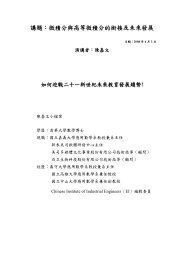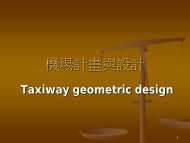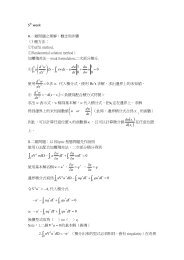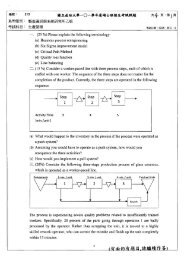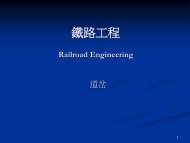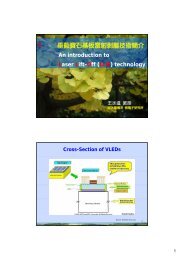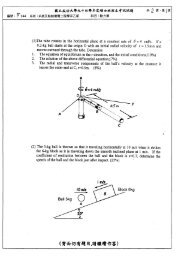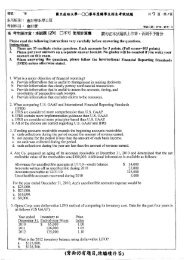The first Transistor
The first Transistor
The first Transistor
Create successful ePaper yourself
Turn your PDF publications into a flip-book with our unique Google optimized e-Paper software.
[ 半 導 體 元 件 概 論 -2009]<br />
3. 雙 極 性 接 面 電 晶 體<br />
(Bipolar Junction <strong>Transistor</strong>, BJT)<br />
王 水 進 教 授<br />
成 大 電 機 系 微 電 子 研 究 所<br />
1<br />
<strong>The</strong> <strong>first</strong> <strong>Transistor</strong><br />
[S. M. Sze, Semiconductor Device Physics and Technology, John Wiley, 1985]<br />
Emitter<br />
Collector<br />
Base<br />
2<br />
1
<strong>The</strong> discovery of the point<br />
contact transistor in 1947<br />
This work resulted in their<br />
receiving the Nobel Prize<br />
for Physics in 1956.<br />
雙 極 性 電 晶 體 發 明 人<br />
[http://www.att.com/technology/history/chronolog/47transistor.html]<br />
3<br />
典 型 BJT 封 裝<br />
[Earl D. Gates, Introduction to electronics, 4/e, Delmar, Thomson Learning Inc., 2001 ]<br />
4<br />
2
Perspective view of an oxide-isolated BJT<br />
[http://ceiba.cc.ntu.edu.tw/542U0130/u0130/electro/form6.htm]<br />
5<br />
Basic structures of BJTs<br />
[D. A. Neamen, Semiconductor Physics and Devices, IRWIN, 1997]<br />
[Encyclopedia Americana, http://go.grolier.com:80/]<br />
Conventional IC npn BJT<br />
An oxide-isolated npn BJT<br />
6<br />
3
NPN Bipolar <strong>Transistor</strong><br />
Planar junction (Bipolar) transistor<br />
Emitter<br />
Base<br />
Collector<br />
Al•Cu•Si<br />
SiO 2<br />
n p n<br />
p +<br />
+<br />
+ n-epi<br />
Electron flow<br />
n + buried layer<br />
P-substrate<br />
p +<br />
7<br />
Cross sections of BJTs<br />
[R. F. Robert, Semiconductor Device Fundamentals, Addison Wesely, 1996]<br />
A typical discrete,<br />
double-diffused pnp BJT<br />
An IC npn BJT<br />
8<br />
4
典 型 雙 極 性 接 面 電 晶 體 結 構<br />
[ 王 水 進 , 電 子 學 - 基 礎 篇 , 全 華 科 技 圖 書 ,1998]<br />
B<br />
E<br />
B<br />
垂 直 型<br />
( 縱 向 型 )<br />
n +<br />
p<br />
n<br />
n +<br />
E<br />
C<br />
B<br />
C<br />
10 20<br />
射 極<br />
n +<br />
基 極<br />
p<br />
集 極<br />
n n +<br />
水 平 型<br />
( 橫 向 型 )<br />
p +<br />
n+<br />
p n +<br />
n<br />
p +<br />
n + − 掩 埋 層<br />
SiO 2<br />
-3<br />
摻 雜 濃 度 (cm )<br />
10 18<br />
10 16<br />
p−<br />
Si基 板<br />
雜 質 分 佈 曲 線<br />
深 度<br />
9<br />
Bipolar junction transistor<br />
[From Wikipedia, the free encyclopedia]<br />
[http://en.wikipedia.org/wiki/Bipolar_junction_transistor]<br />
A bipolar (junction) transistor (BJT) is a type of transistor. It is a three-terminal<br />
device constructed of doped semiconductor material and may be used in<br />
amplifying or switching applications.<br />
Although a small part of the transistor current is due to the flow of majority<br />
carriers, most of the transistor current is due to the flow of minority carriers and<br />
so BJTs are classified as minority-carrier devices.<br />
10<br />
5
<strong>The</strong> bipolar Junction <strong>Transistor</strong>s<br />
[http://dspace.mit.edu/bitstream/handle/1721.1/36373/6-012Spring-2003/NR/rdonlyres/Electrical-Engineering-and-Computer-Science/6-<br />
012Microelectronic-Devices-and-CircuitsSpring2003/DD39CE25-C7AA-4503-999C-5E529728AE6A/0/lecture17.pdf]<br />
11<br />
Concept of<br />
<strong>Transistor</strong> Action<br />
6
雙 極 性 電 晶 體 之 基 本 操 作 :<br />
典 型 pn 接 面 於 偏 壓 下 多 數 與 少 數 載 子 之 電 通 量<br />
[ 王 水 進 , 電 子 學 - 基 礎 篇 , 全 華 科 技 圖 書 ,1998]<br />
順 偏<br />
反 偏<br />
I<br />
n +<br />
p<br />
I o<br />
p<br />
n<br />
I o<br />
I<br />
F pp<br />
>><br />
F nn<br />
F np<br />
F pn<br />
多 數 載 子 電 通 量<br />
少 數 載 子 電 通 量<br />
13<br />
雙 極 性 電 晶 體 之 基 本 操 作 :<br />
不 同 基 極 寬 度 下 由 射 極 注 入 基 極 電 子 流 之 流 動 方 向<br />
順 偏 反 偏<br />
n +<br />
p<br />
n<br />
[ 王 水 進 , 電 子 學 - 基 礎 篇 , 全 華 科 技 圖 書 ,1998]<br />
I E<br />
I C<br />
IE= IC+ IB>><br />
IB<br />
0 W<br />
I B<br />
W
Current components in a BJT<br />
[From Wikipedia, the free encyclopedia]<br />
[http://en.wikipedia.org/wiki/Bipolar_junction_transistor]<br />
15<br />
Carrier transport in a BJT<br />
[http://dspace.mit.edu/bitstream/handle/1721.1/36373/6-012Spring-2003/NR/rdonlyres/Electrical-Engineering-and-Computer-Science/6-012Microelectronic-Devices-and-<br />
CircuitsSpring2003/DD39CE25-C7AA-4503-999C-5E529728AE6A/0/lecture17.pdf]<br />
16<br />
8
Typical output characteristics of a BJT<br />
[Kwok K. Ng, Complete Guide to Semiconductor Devices, 2/e, McGraw-Hill, 2002]<br />
共 基 (CB) 組 態<br />
共 射 (CE) 組 態<br />
17<br />
<strong>Transistor</strong> (= Transfer Resistor)<br />
<br />
v I<br />
i C<br />
V CC<br />
RC<br />
i B +<br />
v CE<br />
-<br />
v O<br />
Load line<br />
V<br />
CC<br />
= i<br />
Q 1 : low resistance<br />
Q 2 : high resistance<br />
C<br />
R<br />
C<br />
+ v<br />
CE<br />
18<br />
9
Switching operation of BJT<br />
V CC<br />
i C RC<br />
i B v O<br />
v I<br />
5V<br />
0<br />
V CC<br />
0<br />
v I<br />
v O<br />
t<br />
t<br />
V<br />
R<br />
CC<br />
C<br />
C<br />
¹¡¦X<br />
B<br />
A<br />
i B<br />
I off<br />
i C<br />
V CC<br />
v CE<br />
0<br />
19<br />
[http://www.interfacebus.com/FETs.html#a]<br />
Operation <strong>The</strong>ory of<br />
BJTs<br />
10
雙 極 性 電 晶 體 之 基 本 操 作 :<br />
由 射 極 注 入 基 極 載 子 流 之 流 動 方 向<br />
[ 王 水 進 , 電 子 學 - 基 礎 篇 , 全 華 科 技 圖 書 ,1998]<br />
n p n<br />
p n p<br />
I E<br />
I C<br />
I E<br />
I C<br />
I B<br />
I B<br />
- V BE<br />
+ -V CB<br />
+<br />
+ V EB<br />
- +V BC<br />
-<br />
21<br />
Definition of BJT operation regions<br />
[S. M. Sze, Modern Semiconductor Device Physics, John Wiley, 1998]<br />
22<br />
11
Minority carrier distribution in an npn BJT<br />
[D. A. Neamen, Semiconductor Physics and Devices, IRWIN, 1997]<br />
23<br />
Carrier profiles in forward-active regime<br />
[http://dspace.mit.edu/bitstream/handle/1721.1/36373/6-012Spring-2003/NR/rdonlyres/Electrical-Engineering-and-Computer-Science/6-012Microelectronic-Devices-and-<br />
CircuitsSpring2003/DD39CE25-C7AA-4503-999C-5E529728AE6A/0/lecture17.pdf]<br />
24<br />
12
Ideal pn junction current<br />
J<br />
J<br />
p<br />
n<br />
J p<br />
(x), J n<br />
(x)<br />
-x p<br />
0<br />
x n<br />
總 電 流<br />
J p ( x n )<br />
J n (x)<br />
Jn( −xp)<br />
J p (x)<br />
Key concept<br />
= qA<br />
= qA<br />
Dp<br />
Lp<br />
Dn<br />
Ln<br />
p<br />
n<br />
no<br />
po<br />
⋅e<br />
⋅e<br />
VA<br />
/ VT<br />
VA<br />
/ VT<br />
⎫<br />
⎪<br />
⎬<br />
⎪<br />
⎭<br />
⇒<br />
J<br />
J<br />
p<br />
n<br />
N<br />
∝<br />
N<br />
A<br />
D<br />
x<br />
I = AJ = A[<br />
J<br />
Dn<br />
= qA[(<br />
n<br />
L<br />
I<br />
= I<br />
o<br />
o<br />
( e<br />
= qA[<br />
= qA[(<br />
∝ e<br />
n<br />
VA<br />
V T<br />
−<br />
−1)<br />
D<br />
L<br />
Eg<br />
kT<br />
p<br />
po<br />
n<br />
n<br />
n<br />
D<br />
L<br />
( xn)<br />
+ J<br />
Dp<br />
+ p<br />
L<br />
po<br />
n<br />
nND<br />
p<br />
+<br />
+<br />
n<br />
( −x<br />
no<br />
Dp<br />
Lp<br />
Dp<br />
L N<br />
p<br />
)( e<br />
A<br />
p<br />
p<br />
)]<br />
V A<br />
V T<br />
−1)]<br />
no<br />
]<br />
)] n ]<br />
2<br />
i<br />
25<br />
Derivation of I-V equations of BJTs<br />
x<br />
<br />
x n<br />
Eo<br />
p<br />
x x LE<br />
P n P<br />
pn( x)<br />
nx ( ) = n −Δnx ( ) e<br />
Co<br />
0 ≤ x ≤W B<br />
n<br />
−( x−xn)/<br />
LC<br />
nE ( x)<br />
n Eo<br />
− x p<br />
p Bo<br />
0<br />
W B<br />
nC ( x )<br />
− x n<br />
p Co<br />
−W<br />
/ L<br />
B B<br />
B<br />
ΔpW ( B ) − Δp( 0)<br />
e<br />
x/<br />
L ΔpW ( B ) − Δp( 0)<br />
e<br />
B<br />
px ( ) = pBo[(<br />
) e − (<br />
2 sinh( W / L )<br />
2 sinh( W / L )<br />
B<br />
B<br />
B<br />
W / LB<br />
B<br />
− x/<br />
L<br />
B<br />
) e ]<br />
27<br />
13
Derivation of I-V equations of BJTs<br />
I E = AE<br />
( J pE + J nE ) = AE<br />
[ J p ( x = 0) + J n ( x = − x p )]<br />
∂ p ( x )<br />
∂ n(<br />
x)<br />
= AE<br />
[( − q D B<br />
x = 0 ) + ( − q D E<br />
x = − x )]<br />
p<br />
∂ x<br />
∂ x<br />
q D B p Bo W<br />
= A<br />
coth ( B )[( V EB / VT<br />
E<br />
e − 1)<br />
L B L B<br />
1<br />
− ( −V<br />
BC / V<br />
q D E n EO<br />
e<br />
T − 1)] + A<br />
( V EB / VT<br />
E e − 1)<br />
W B<br />
cosh ( )<br />
L<br />
L<br />
E<br />
B<br />
I C = AC<br />
( J pC + JnC<br />
) = AC<br />
[ J p(<br />
x = WB<br />
) + Jn(<br />
x = xn)]<br />
∂ px ( )<br />
∂ nx ( )<br />
= ( − qDB x= W ) + ( −qDC x=<br />
x )<br />
∂x<br />
B<br />
∂x<br />
n<br />
−<br />
= A qD B p Bo 1 V W<br />
EB VT B VBC VT<br />
C<br />
[( e<br />
−1) −coth( )( e<br />
W<br />
L<br />
B<br />
B sinh( ) L<br />
L<br />
B<br />
B<br />
−1)]<br />
−<br />
−A C n Co VBC<br />
/ VT<br />
C ( e<br />
LC<br />
−1)<br />
28<br />
Minority carrier distribution in an npn BJT<br />
operating in the active mode<br />
[A. S. Sedra and K. C. Smith, Microelectronic Circuits, Oxford Univ. Press, 1998]<br />
Emitter<br />
(n)<br />
E-B<br />
depletion region<br />
Base<br />
(p)<br />
B-C<br />
depletion region<br />
Collector<br />
(n)<br />
n p (0)<br />
p n (0)<br />
p no<br />
n (0) = n<br />
p<br />
p (0) = p<br />
n<br />
e<br />
vBE<br />
/ VT<br />
po<br />
vBE<br />
VT<br />
noe<br />
/<br />
0<br />
I n<br />
n p (x)<br />
(ideal)<br />
n p (x)<br />
W<br />
(with recombination)<br />
I<br />
n<br />
dnp(<br />
x)<br />
= AE<br />
qDn<br />
dx<br />
np<br />
( o)<br />
= AE<br />
qDn<br />
( − )<br />
W<br />
x<br />
29<br />
14
Minority carrier distribution in an npn BJT<br />
operating in the active mode<br />
[S. M. Sze, Semiconductor Devices, Physics and Technology, John Wiley, 1985]<br />
30<br />
Minority carrier distribution in an npn BJT<br />
[D. A. Neamen, Semiconductor Physics and Devices, IRWIN, 1997]<br />
Saturation<br />
Cut-off<br />
31<br />
15
熱 平 衡 狀 態 下 BJT 之 能 帶 圖<br />
[R. F. Robert, Semiconductor Device Fundamentals, Addison Wesely, 1996]<br />
32<br />
順 向 作 用 區 工 作 電 晶 體 之 能 帶 圖<br />
結 構 示 意 圖<br />
+ −<br />
E<br />
+<br />
X E<br />
p<br />
X B<br />
n<br />
X C<br />
p<br />
I C<br />
−<br />
C<br />
能 帶 圖<br />
I E<br />
V EB<br />
電 荷 分 佈 圖<br />
V EC<br />
I B<br />
− +<br />
B<br />
V BC<br />
qV<br />
E CB qV c CE<br />
qV EB<br />
E v<br />
qN ( D − NA)<br />
N B<br />
x n<br />
− x p<br />
0 W B<br />
x<br />
N C<br />
N E<br />
33<br />
16
電 晶 體 之 能 帶 圖<br />
p<br />
n<br />
p<br />
n<br />
p<br />
n<br />
E c<br />
E c<br />
E v<br />
E v<br />
熱 平 衡<br />
狀 態<br />
E c<br />
E v<br />
E F<br />
E c<br />
E v<br />
E v<br />
qV Do<br />
E F<br />
qV Do<br />
qV D<br />
順 向 操 作<br />
狀 態<br />
E c<br />
E v<br />
E c<br />
qV CB qV CE qV qVCB<br />
EB<br />
qV CE<br />
qV EB<br />
qV D<br />
34<br />
E<br />
I B<br />
pnp 電 晶 體 之 電 流 成 份<br />
p n p<br />
I E<br />
I Ep<br />
( Ep − ICp)<br />
I Cp I C<br />
+<br />
I CBOp<br />
I En<br />
I CBOn<br />
-<br />
C<br />
I<br />
I<br />
Ep<br />
γ ≡ ≈1−<br />
E<br />
σ BW<br />
σ W<br />
E<br />
V EB<br />
Emitter efficiency<br />
α T<br />
I<br />
I<br />
Cp<br />
≡ ≈1<br />
−<br />
Ep<br />
W<br />
B<br />
E<br />
2<br />
B<br />
2<br />
p<br />
2 L<br />
-<br />
B<br />
Base transport efficiency<br />
CB SC current gain<br />
I<br />
I<br />
C<br />
α( ≡ = γα )<br />
E<br />
T<br />
+<br />
V BC<br />
IE = IEp + I En<br />
I = I + ( I − I ) − I<br />
B En Ep Cp CBO<br />
I E = I C + I B<br />
I ( = I + I )<br />
CBO CBOp CBOn<br />
I = αI + I<br />
C E CBO<br />
I = I + I = γ α I + I<br />
C Cp CBO T E CBO<br />
35<br />
17
Diffusion currents flowing in<br />
a pnp BJT under active mode biasing<br />
[R. F. Robert, Semiconductor Device Fundamentals, Addison Wesely, 1996]<br />
CB dc current gain α dc<br />
I Cp = αT<br />
I Ep = γ αT<br />
I<br />
Emitter efficiency Base transport factor<br />
E<br />
I<br />
I<br />
γ = EP<br />
ICP<br />
C = α dcIE<br />
+ ICB0<br />
= ICp<br />
+ ICn<br />
α T =<br />
IE<br />
I<br />
= γ α I + I<br />
EP<br />
T<br />
E<br />
Cn<br />
⇒<br />
α<br />
dc<br />
= γ α ,<br />
T<br />
I<br />
CB0<br />
= I<br />
Cn<br />
I<br />
C<br />
= β<br />
= α<br />
CB dc current gain β dc<br />
dc<br />
dc<br />
IB<br />
+ I<br />
( I + I<br />
C<br />
CB0<br />
B<br />
= α<br />
) + I<br />
I<br />
dc E<br />
CB0<br />
+ I<br />
CB0<br />
α dc 1<br />
IC<br />
= IB<br />
+ I<br />
1−α<br />
dc 1−α<br />
dc<br />
= β dcIB<br />
+ (1 + β dc)<br />
I<br />
α dc<br />
β dc<br />
−α<br />
dc<br />
CB0<br />
CB0<br />
36<br />
= 1<br />
37<br />
Current-Voltage Characteristics of BJTs<br />
(Gummel plot)<br />
[B. G. Streetman and S. Banerjee, Solid State Electronic Devices, Prentice Hall, 2000]<br />
High level<br />
injection<br />
Base resistance<br />
ideal<br />
ideal<br />
V EB<br />
log I C<br />
ideal<br />
37<br />
18
Gummel plot and dc current gain<br />
[R. F. Robert, Semiconductor Device Fundamentals, Addison Wesely, 1996]<br />
Ideal<br />
High-level injection,<br />
current crowding,<br />
and/or series resistance<br />
β dc<br />
V BC = 5V<br />
Ideal<br />
V EB<br />
I C<br />
(A)<br />
Data derived from a 2N2605 pnp BJT<br />
38<br />
Gummel plot: semilog plot of IC and IB vs. VBE<br />
[http://dspace.mit.edu/bitstream/handle/1721.1/36373/6-012Spring-2003/NR/rdonlyres/Electrical-Engineering-and-Computer-Science/6-<br />
012Microelectronic-Devices-and-CircuitsSpring2003/DD39CE25-C7AA-4503-999C-5E529728AE6A/0/lecture17.pdf]<br />
39<br />
19
Gummel plot of BJT (VCE = 3 V )<br />
[http://dspace.mit.edu/bitstream/handle/1721.1/36373/6-012Spring-2003/NR/rdonlyres/Electrical-Engineering-and-Computer-Science/6-012Microelectronic-Devices-and- 40<br />
CircuitsSpring2003/DD39CE25-C7AA-4503-999C-5E529728AE6A/0/lecture17.pdf]<br />
Current-Voltage<br />
Characteristics of BJTs<br />
41<br />
20
BJT 應 用 之 三 種 組 態<br />
[ 王 水 進 , 電 子 學 - 基 礎 篇 , 全 華 科 技 圖 書 ,1998]<br />
+<br />
I B<br />
V<br />
+<br />
CE<br />
V BE<br />
−<br />
I E<br />
I C<br />
−<br />
V BE<br />
+ I B<br />
−<br />
V CB<br />
V<br />
−<br />
CB<br />
I<br />
+<br />
C<br />
I E I C<br />
−<br />
+<br />
I B<br />
I E<br />
−<br />
V CE<br />
+<br />
共 射 (CE) 組 態<br />
共 基 (CB) 組 態<br />
共 集 (CC) 組<br />
42<br />
共 基 (CB) 組 態 電 晶 體 特 性<br />
I E<br />
(mA)<br />
10<br />
8<br />
6<br />
VCB = 15V<br />
VCB = 10V<br />
VCB = 5V<br />
4<br />
2<br />
0<br />
0.6 0.7 0.8 0.9<br />
V BE<br />
(Volts)<br />
I C<br />
(mA)<br />
10<br />
8<br />
6<br />
4<br />
2<br />
IE = 10 mA<br />
IE = 8 mA<br />
IE = 6 mA<br />
IE = 4 mA<br />
IE = 2 mA<br />
I CBO<br />
IE = 0 mA<br />
0 1 2 3 4 5 6<br />
VBE ( Volts)<br />
I E I C<br />
I B I B<br />
I E I C<br />
−<br />
V BE<br />
+<br />
+<br />
V CB<br />
−<br />
+<br />
V EB<br />
−<br />
−<br />
V BC<br />
+<br />
43<br />
21
共 射 (CE) 組 態 電 晶 體 特 性<br />
3<br />
20<br />
18<br />
16<br />
I B =100 uA<br />
I B<br />
(μA)<br />
2<br />
1<br />
VCE = 5V<br />
VCE = 15V<br />
I C (mA)<br />
14<br />
12<br />
10<br />
8<br />
6<br />
80 uA<br />
60 uA<br />
40 uA<br />
4<br />
20 uA<br />
0 04 . 06 . 08 . 10 . 12 . 14 .<br />
VBE ( Volts)<br />
2<br />
0 uA<br />
0<br />
0.0 0.5 1.0 1.5 2.0 2.5 3.0 3.5 4.0<br />
V CB (V)<br />
I C<br />
I C<br />
I B<br />
+<br />
+<br />
V CE<br />
V BE −<br />
I<br />
−<br />
E<br />
−<br />
V EB<br />
+<br />
I B<br />
I E<br />
−<br />
V EC<br />
+<br />
44<br />
Typical output characteristics of a BJT<br />
[Kwok K. Ng, Complete Guide to Semiconductor Devices, 2/e, McGraw-Hill, 2002]<br />
共 基 (CB) 組 態<br />
共 射 (CE) 組 態<br />
45<br />
22
共 集 (CC) 組 態 電 晶 體 特 性<br />
I B (mA)<br />
20<br />
18<br />
15<br />
13<br />
V CB = 5 V<br />
V CB = 10 V<br />
V CB = 15 V<br />
10<br />
8<br />
5<br />
3<br />
0<br />
0 2 4 6 8 10 12 14 16<br />
V CB (V)<br />
I E (mA)<br />
20<br />
18<br />
16<br />
14<br />
12<br />
10<br />
8<br />
6<br />
4<br />
2<br />
IB = 100 μ A<br />
80 μA<br />
60 μA<br />
40 μA<br />
20 μA<br />
0 μA<br />
0<br />
0.0 0.5 1.0 1.5 2.0 2.5 3.0 3.5 4.0<br />
V CE (V)<br />
I E<br />
I E<br />
−<br />
V BC<br />
+<br />
I B<br />
I C<br />
−<br />
V CE<br />
+<br />
+<br />
I B<br />
V BC I −<br />
+<br />
−<br />
C<br />
V EC<br />
46<br />
Figure-of-Merit (FOM) for BJT performance<br />
[S. M. Sze, Modern Semiconductor Device Physics, John Wiley, 1998]<br />
Current gain cutoff frequency, f T<br />
<strong>The</strong> frequency at which the short-circuit current gain (h fe<br />
, or β) drop to<br />
unity.<br />
A key estimator of transistor high-speed performance<br />
1<br />
wc<br />
( kT / q)<br />
= τ b + τ e'<br />
+ + ( RE<br />
+ RC<br />
) CBC<br />
+ ( CBE<br />
+ CBC<br />
)<br />
2π fT<br />
2vs<br />
IC<br />
Maximum frequency of oscillation, f max<br />
<strong>The</strong> frequency at which the maximum available power gain (MAG) of<br />
the transistor drops to unity.<br />
F max<br />
is different from (and typically larger than) f T<br />
, because in<br />
addition to current gain, f max<br />
takes into account the possibility of<br />
voltage gain.<br />
fmax 2 1 Re( Zin)<br />
2<br />
G p = ( ) = [ ] h fe<br />
f 4 Re( Zout<br />
)<br />
T 1/ 2<br />
max ( )<br />
8π RBCBC<br />
f =<br />
f<br />
Figure of Merit: 效 益 指 數 、 評 量 指 標<br />
47<br />
23
Figure-of-Merit for BJT performance<br />
[S. M. Sze, Modern Semiconductor Device Physics, John Wiley, 1998]<br />
48<br />
Non-ideal effects of BJTs<br />
49<br />
24
BJT 之 穿 透 崩 潰 (punch-through breakdown)<br />
W B<br />
E<br />
N + P N<br />
C<br />
punch-through<br />
breakdown voltage<br />
Depletion<br />
region<br />
B<br />
V<br />
2<br />
PT B B s<br />
( = qN W / 2ε )<br />
W B<br />
V B<br />
E<br />
N + P N<br />
B<br />
Depletion<br />
region<br />
C<br />
ΔV B<br />
發 生 穿 透 崩 潰 時<br />
V + V<br />
bi CB<br />
E c<br />
E c<br />
50<br />
電 晶 體 與 兩 端 間 之 崩 潰 曲 線 ( 第 三 端 開 路 )<br />
I<br />
1<br />
M =<br />
V<br />
1 − ( )<br />
I CEO<br />
BV CBO<br />
m<br />
I<br />
CEO<br />
BV CEO<br />
I CBO<br />
BV CBO<br />
1/ m<br />
β<br />
I CBO<br />
=<br />
1−α<br />
M<br />
V<br />
BV<br />
CEO<br />
= BV<br />
BV<br />
≈<br />
CBO<br />
CBO<br />
(1−<br />
α)<br />
I B = 0<br />
I CEO<br />
I CBO<br />
I E = 0<br />
1/ m<br />
51<br />
25
<strong>The</strong> avalanche breakdown in a transistor<br />
[B. G. Streetman and S. Banerjee, Solid State Electronic Devices, Prentice Hall, 2000]<br />
52<br />
Carrier multiplication and feedback mechanism<br />
[R. F. Robert, Semiconductor Device Fundamentals, Addison Wesely, 1996]<br />
0: initial hole injection<br />
1: injected hole entering the CB<br />
depletion junction<br />
2: e-h pair generation by impact ionization<br />
3: generated electrons being swept<br />
into the vase<br />
4: excess base electrons injected<br />
into the emitter<br />
5: hole injected from the emitter<br />
into the base in response to the<br />
step 4 electron injection<br />
53<br />
26
Non-ideal I-V characteristics of BJTs<br />
[R. F. Robert, Semiconductor Device Fundamentals, Addison Wesely, 1996]<br />
Non Early effect<br />
no carrier multiplication<br />
With Early effect and<br />
carrier multiplication<br />
With Early effect<br />
no carrier multiplication<br />
54<br />
<strong>The</strong> Early effect<br />
[B. G. Streetman and S. Banerjee, Solid State Electronic Devices, Prentice Hall, 2000]<br />
55<br />
27
Dependence of i C on the collector voltage –<br />
the Early effect<br />
[A. S. Sedra and K. C. Smith, Microelectronic Circuit, Oxfor Univ. Press, 1998]<br />
i<br />
C<br />
v<br />
/ CE<br />
= I v V<br />
Se<br />
BE T (1 + ) Output resistance<br />
V<br />
A<br />
⎡ ∂i<br />
ro<br />
≡ ⎢<br />
⎣∂v<br />
C<br />
CE<br />
vBE<br />
=const.<br />
⎤<br />
⎥<br />
⎦<br />
−1<br />
56<br />
Geometrical effect-<br />
current crowding<br />
Emitter area ≠ collector area<br />
Bulk and contact resistance<br />
(using thin epilayer or heavily doped buried layer)<br />
57<br />
28
Current crowding<br />
58<br />
Cross section of a BJT under active bias<br />
C-B<br />
space-charge<br />
layer<br />
Collector region<br />
Lines of flow of<br />
majority carriers<br />
<strong>The</strong> base current is supplied form two side base contact and flows<br />
toward the center of the emitter causing the BE voltage drop to vary<br />
with position.<br />
62<br />
29
Base resistance<br />
Extrinsic base resistance<br />
ρBX<br />
L ρBX<br />
d<br />
R1<br />
= =<br />
A ( x + x ) W<br />
E<br />
B<br />
Intrinsic base resistance<br />
R<br />
2<br />
ρBIh<br />
=<br />
3x<br />
W<br />
B<br />
Base resistance<br />
R = r<br />
b<br />
= RC<br />
+ R1<br />
+ R2<br />
x<br />
63<br />
Effect of Base Resistance<br />
[B. G. Streetman and S. Banerjee, Solid State Electronic Devices, Prentice Hall, 2000]<br />
64<br />
30
An interdigitated geometry<br />
to release the effects of emitter current crowding<br />
[B. G. Streetman and S. Banerjee, Solid State Electronic Devices, Prentice Hall, 2000]<br />
top view of<br />
implanted region<br />
65<br />
Geometry design of power BJTs<br />
66<br />
31
<strong>Transistor</strong> collector resistance R CS<br />
In active region<br />
the collector junction is reveres biased<br />
and hence represents a rather high<br />
impedance. <strong>The</strong> collector voltage<br />
drop I C<br />
R CS<br />
is normally small<br />
compared to the collector junction<br />
resistance and can be neglected.<br />
In saturation region<br />
<strong>The</strong> collector junction is forward biased, the collector bulk voltage drop<br />
generally even exceeds the potential drop across the junction.<br />
<strong>The</strong> effect is most pronounced at low CE voltages where the BJT<br />
is in saturation and hence is collecting minority carrier inefficiently<br />
(the collector is back injection to the emitter).<br />
67<br />
Emitter-collector shorts caused by diffusion pipes or spikes<br />
through the base along the dislocations<br />
Diffusion pipes<br />
Diffusion spikes<br />
Dislocations:<br />
oxidation induced stacking faults, epitaxial-growth-induced<br />
slip dislocations, and other process-induced defects<br />
68<br />
32



